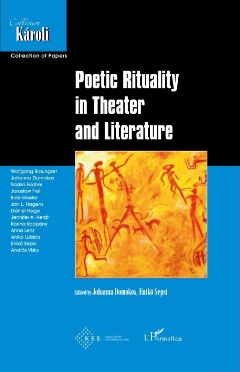
Page 41 [41]

OCR
POETIC RITUALITY AND TRANSCULTURALITY One might think of Hugo von Hofmannsthals’ opera Elektra (1909), composed by Richard Strauss, or Vaslav Nijinski’s production of Le Sacre du Printemps that caused a scandal in 1913 when performed in Paris because of its ritualistic aesthetics that deliberately violated the boundaries of classical ballet. These forms of ritual self-sacrifice refer to both the Russian (Le Sacre du Printemps) and the ancient Greek (Elektra) context, drawing on sacrifices as gestures of reconciliation that ultimately aim to restore harmony, for which the ritual unfolds the tension motivating the sacrifice, gradually bringing them closer together and initiating reconciliation.”” Through a scapegoat, the banishment of the scapegoat from the community, and his sacrifice, the social group can reunite around a higher meaning. This way, the social group gains a ritualistic center that represents the highest sacred value and demands devotion to it. Especially in modern times and under social conditions where the suffering of the individual cannot simply be subordinated to a higher meaning, such ritual practices are highly provocative. However, it was also the aesthetic innovation, the departure from a sublime — not ecstatic — and cruel aesthetic that posed an enormous challenge artistically but also reformed, for instance, the ballet. Brecht’s play Die Maßnahme refers in a complex way to different ritual practices and genres of ritual theater from the Christian as well as from the Japanese background and places them in a political context. Yet it is astonishing that Brecht — the advocate of a “theater of the scientific age,” as he called it — made use of the ritual, for in his theoretical writings, Brecht had declared the rejection from the cult to be the very sign of his epic and self-enlightened theater." Above all, Die Maßnahme is controversial and problematic for the precise reason that Brecht seems to affirmatively stage the self-sacrifice of a young revolutionary and the justification of his killing in favor of the communist idea. The play refuses to take a clearly distant or critical approach to the performed self-sacrifice for which the death of the young revolutionary is glorified. It is due to this identification of dying for the communist idea with Christian sacrifice that has led to the accusation that Brecht was a supporter of the communist ideology. Does Brecht, in favor of a political belief, abandon all criticism he himself made against the alliance between ritual and theater? Is Die Mafsnahme merely the representation of the self-sacrifice one undertakes for the revolution? Howard Smither compares Die Maßnahme and its Yet it is a clichéd and folkloristic idea of Russian tradition. Jürgen Raab — Hans-Georg Soeffner: Pina Bauschs Inszenierung Le Sacre du Printemps. Eine Fallanalyse zur Soziologie symbolischer Formen und ritueller Ordnungen, in G. Brandsetter — G. Klein (eds.): Methoden der Tanzwissenschaft. Modellanalysen zu Pina Bauschs ‘Le Sacre du Printemps / Das Friihlingsopfer’, Bielefeld, transcript Verlag, 2015, 233-250. 28 Bertolt Brecht: Kleines Organon fiir das Theater, in W. Hecht — J. Knopf - W. Mittenzwei — K.-D. Müller (eds.): Bertolt Brecht Werke. Große kommentierte Berliner und Frankfurter Ausgabe, Vol. 23, Berlin/Weimar/Frankfurt a.M., Suhrkamp, 1989-1998, 67. In the following footnotes this edition will be referred to by the abbreviation GBA. + 39 +
structurelles
Custom
Image Metadata
- Largeur de l'image
- 1830 px
- Hauteur de l'image
- 2834 px
- Résolution de l'image
- 300 px/inch
- Taille du fichier d'origine
- 1.34 MB
- Lien permanent vers jpg
- 022_000047/0040.jpg
- Lien permanent vers OCR
- 022_000047/0040.ocr
